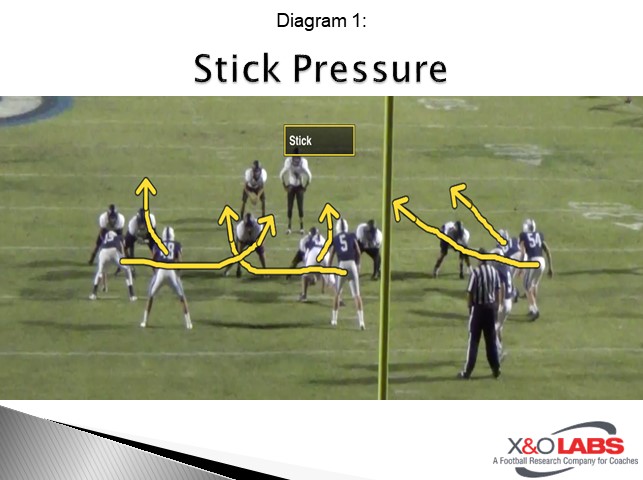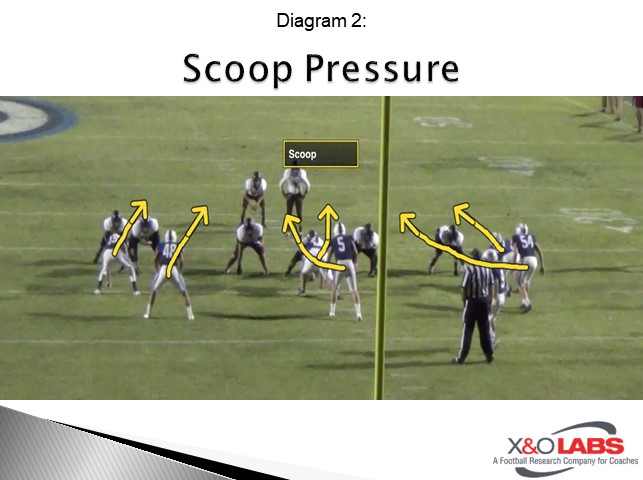By Mason Hughes
Head Coach
Central Valley Christian High School (CA)
Twitter: @mason_hughes
At Central Valley Christian, we employ a 3-3 stack defense with quarter’s coverage. We believe that the best way to defend the modern high school offense is to base out of a 2-high safety look. However, modern offenses are too good at making adjustments if the defense only runs one scheme. In order to combat the offense, we believe that we must blitz. We use 4, 5, 6, and 7-man pressures to disrupt the offense and cause chaos. In each of those pressure schemes, we incorporate a different type of coverage behind the pressure (pattern matching zone with 4 and 5-man pressures, true man-to-man with 7-man pressures, and spot dropping with 6-man pressures).
One of our most successful pressures has been our 6-man pressure scheme with true spot dropping zone principles. When these pressures with spot dropping zones coverages are coupled with our other pattern match and man-to-man coverages in our defensive game plan, it allows for our defense to create chaos to the offense and keeps the offense on edge. We believe that the spot dropping zone coverage allows for the defenders in coverage to make plays on poorly thrown, or rushed passes by the quarterback, and often results in interceptions and big plays from our defense. Since the coverage defenders are spot dropping with their eyes on the quarterback, we believe that this pressure scheme is also effective against run plays and screens. These pressures and coverages made up 10% of our defensive calls this past season, yet yielded over 30% of our forced turnovers and sacks.
The Basics
We employ 3 defensive linemen, 3 linebackers, 3 safeties, and 2 corners in our defense. Two of our safeties (Bandit and Will) can play low as a linebacker or high as a true 2-high safety. Our Free safety will always be a true 2-high safety player. This allows for many different blitzes, but we have found that there are two pressure paths that attack the types of run plays and pass protections that we see the most.
We like to think of our pressures as “plays” or patterns for the defense. The two 6-man pressure patterns that we run are in diagrams 1 and 2 below.


We can blitz any of the 11 players on the field based on calls, but the paths are all broken down into these two basic patterns.
Coaching Points:
Below are the coaching points for each type of player in our 6-man pressures.
Slanting defensive linemen:
- Attack the slant side shoulder of the offensive lineman in front of you
- Hands before feet
- Eyes below his chin
- In pass situations, you can use pass rush moves immediately
- In run situations, you must remain square to the line of scrimmage and use stimulus-response (down=squeeze, reach=press, and mirror, base=extend)
Long sticking defensive linemen:
- Attack the inside shoulder of the guard you are sticking to
- Feet before hands
- Eyes below his chin
- In pass situations, you can use pass rush moves immediately
- In run situations, you must remain square to the line of scrimmage and use stimulus response on the guard (down=squeeze, reach=press, and mirror, base=extend)
Blitzers:
- In run situations, the pre-snap movement must be minimal
- In pass situations, the pre-snap movement must occur
- Learn the snap count, bluff early, get momentum if you can
- Use your hands, not shoulders
- In run situations react to blocks as you would on non-blitzing plays, just do it on the move
- In pass situations use chop and rip moves on the blocker, finish the play – hitting the quarterback is always better than jumping to deflect his pass
Hash Droppers:
- Play the run first, if run you are responsible for forcing the ball back inside
- If pass, drop/move to a landmark of 10 yards deep and just outside the hash mark on your side
- Eyes must be on the quarterback let his face move you laterally
- You must feel receivers in your area
- Use pedal, turn/run or shuffle technique to get to your drop
- Once the quarterback takes his front hand off the football to throw break in the direction he is throwing – looks to intercept the ball
- Make sure to not get too wide, we want to defend curls and rally to passes in the flats








